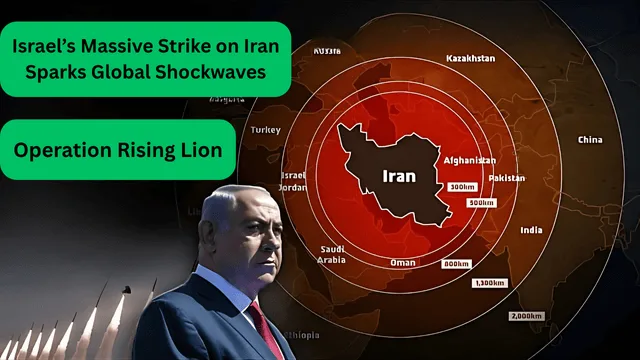1. Introduction to India’s Next Big Leap
India’s Bold Move Towards a Digital Address Revolution, following UPI and Aadhaar. In this digital revolution, all establishments in India, whether residential or commercial, will be issued a digital ID. You can see the news soon. Every Indian address will get a unique digital ID.
2. What Is a Digital Address ID?
So let’s understand a little bit about what this is. It means creating an Aadhaar for a place means creating a digital ID. What does this mean? Why are we doing this? What will be the benefit of this? You will understand all that in detail. Let’s move ahead.
3. Vision and Background
As you can see, the government of India is now preparing to launch digital IDs for physical addresses. As you must have seen, the place where you are sitting and watching this video must have some location or the other.
4. From PIN to DG PIN: What Changes?
You must have seen that whenever you send an address to someone, there is a PIN in it. Right? It has a PIN code, a numerical code. In the same way, an attempt is being made here to create a digital ID for a place.
And you can say that the strategy of the Government of India regarding digital public infrastructure is being further advanced, and this is a big initiative after Aadhaar and UPI.
5. Understanding the Need for Digital Address ID
Aadhaar, as you know, is the digital identity of an individual. UPI is a digital platform for payment. In the same way, all the houses, businesses, and public places in the country will also have digital IDs so that our overall governance ecosystem can be improved further.
6. What is the Digital Address ID (DG PIN) Project?
6.1 Evolution from PIN Codes
The Centre is working to create a digital address code, which we can call DG PIN. Till now, you must have heard about PIN code, PIN is a Postal Index Number code.
Whether it is Delhi, Mumbai, or even different places in Delhi-Mumbai, suppose if this is the entire Delhi area, then this area will have a particular PIN code. Then this area has another PIN code.
6.2 India’s Existing PIN Code System
So, in this way, we identify it by PIN code. So here you can see that there are a total of 19,101 PIN codes in India, which cover 1,54,000 post offices, and the PIN code system started in 1972, and it is a six-digit code.
6.3 Every Property Gets a Unique DG PIN
Similarly, what we are saying here is that every place means here we are not talking about the overall area, that if there are 100 houses in this area, then all of them have the same DG PIN. It is not like this.
Every house or every shop will have a DG PIN, and it will be an alphanumeric code of about 10 characters.
7. Technical Structure and Working
7.1 Alphanumeric Format Like PAN
As you must have seen, PAN has alphanumeric numbers. There are also A, B, C, D, and there are other numbers in it. So the same kind of effort is being made here.
7.2 Similar to Aadhaar and UPI
Just like Aadhaar is a unique ID for people. Aadhaar is a unique ID for an individual. UPI is for payment. Similarly, the DG PIN will be a unique digital code for every place.
7.3 Based on Geo-Coordinates
You must have heard about Jio Special. About Jio Special Coordinate, in which we will be able to identify that place through latitude and longitude.
7.4 Precision in Location
So if you look at it, it becomes 26° north and at the same time it becomes 78° east. In this way, every particular place has its unique longitude and latitude. So, wherever that place is, we will give it a 10-character alphanumeric code that indicates that place is there.
8. Why India Needs a Digital Address System
8.1 Address Ambiguity in India
Look, there is a problem with the address in India. Yes, this is correct. If you see the addresses in India, they are very ambiguous. There is no particular pattern. There is no standard.
8.2 Landmark Dependency Issues
Often, you must have seen that it is written in the address that you type the landmark. Wherever you are filling out any form, it is compulsory to tell the landmark that it is behind the temple. There is a banyan tree in front, or there is a Mother Dairy booth.
Many times, there is another Radha Krishna temple a few meters away. So many times, the delivery people arrive there. So such issues arise.
8.3 Impact on Emergency Services and Daily Life
So this creates confusion, delays, and delivery errors. Suppose there is a fire somewhere, and an ambulance has to be called. You are thinking that you do not know the address.
You walk on the road. If you walk on the road the whole day, you will see that 10 people will come and ask you, that Bhaiya, where is this address?
9. Economic and Developmental Implications
9.1 Impact on E-commerce and Logistics
In today’s date of e-commerce era, everything is coming to the home. Be it logistics, utility billing, meter readings, or postal deliveries. So the address plays a very important role in all this.
9.2 Economic Loss Due to Inefficiencies
Studies believe that India loses 10 to 14 billion dollars every year. Because you understand that if you are searching for an address, then you mean half an hour is spent searching for the address. So half an hour has value, right?
9.3 Challenges in Rural Governance
Many, in fact, rural areas which are informal settlements, there is no formal address system. Due to this, there are a lot of problems in governance and development.
10. Features of DG PIN System
10.1 Permanent and Verifiable
Just like a person has a digital ID through Aadhaar in which our biometrics are there… In the same way, if we mark this place and give it a DGPIN, then it is not like that. Now this is land, it is not going to be shifted anywhere.
10.2 Universality Across All Areas
Whether it is rural areas, cities, forests or public utilities, it will be the same for everyone, that is, it will be DGPIN, so there will be no confusion here.
10.3 Coordinated with GPS
The most important thing is that we are coordinating it with GPS. Meaning, if GPS coordinates are there, then this is not the case here. You can exactly tell from the door that this door of this house is here.
11. Governance and Service Delivery Benefits
11.1 Improved Targeting of Subsidies and Welfare
Here, the subsidies that the government has to give, property tax notices have to be given, and welfare schemes have to be implemented — now the government will be able to go to that location and do the government delivery here.
11.2 Alignment with Digital India and Smart City Goals
Jio Special Intelligence Smart City Government is focusing on Digital India, so this is going to be very useful in that.
12. Emergency and Disaster Management
12.1 Efficient Emergency Response
During disaster and emergency, suppose suddenly there is a need for an ambulance, disaster relief has to be delivered, okay, an earthquake has come — then in all those situations you can understand how much useful this is going to be.
12.2 Better Rescue Coordination
Rescue coordination, etc., which I was telling you, will also become important.
13. Boost to Economy and Efficiency
13.1 Smoother Last-Mile Deliveries
As I was telling you, SWGI Zomato courier is coming to your house. A lot of deliveries today, two to four deliveries keep coming to your house every day. This is the situation. So it will become very smooth.
13.2 Elimination of Repeated Calls and Confusion
You will not be called again and again and told, “Sir, we have reached here.” Now, when you reach where you want to go, you start guiding. You leave your work and get busy with that. You will not have to do all that.
14. Real Estate, Insurance, and Urban Planning
14.1 Boost to Real Estate
Real estate will get a big boost. Infrastructure planning will get a boost.
14.2 Insurance Mapping and Fraud Prevention
Insurance mapping will be done properly. Apart from this, the most important thing is fraud prevention. I mean, the duplication that is happening here these days — property is being sold by showing fake property documents — all that will also end now.
14.3 Integration with Municipal Services
We can integrate it properly into the municipal records. Property tax, smart meter, and sewage planning have been done. So now you will be able to plan properly.
14.4 Automated Urban Approvals
Automated building plans will be approved. The government will be able to easily do this through digital maps, etc.
15. Privacy and Data Security
15.1 Consent-Based Access
Just like in the case of Aadhaar today, no data will be shared without your consent. In the same way, this project is also built on the same principle — your DG PIN, your home address, which is an alphanumeric code, cannot be used without your consent.
15.2 Role of Digital Address Authority
No agency, government, or private entity will be able to access and share the digital address without the owner’s consent. And the digital address authority that is being proposed here — means just like you must have heard about UIDI in the case of Aadhaar — similarly here also a digital address authority will be formed which will govern this entire law.
15.3 Compliance with Data Protection Act
So that the Digital Personal Data Protection Act can be complied with, here the interoperability across platforms can be done — that is, the records with the state, logistics with the banks, everyone can easily transfer it.
15.4 Deactivation and Updates
And along with this, the code here, if suppose a code has been made for a place but now it has to be abolished because something else is happening there — that is, suppose the government is doing evacuation, then anything is happening — like in the case of Aadhaar also, if suppose an illegal immigrant comes to India from Bangladesh, then his Aadhaar has to be cancelled, in the same way these codes can also be cancelled.
16. Timeline and Implementation
16.1 Current Status and Upcoming Steps
Look, for now, it is just the beginning. Talks are going on. The government may release the draft proposal for public consultation very soon, in mid-2025, within the next 1-2 months.
16.2 Blueprint and Legislation
Then, its final implementation blueprint can be done by the end of 2025. Then, apart from this, the law bill will have to be passed in the Parliament. So maybe in the winter session, the government may try to get it done.
16.3 Trial Rollouts and Nationwide Expansion
And then, apart from this, it will be rolled out in some selected cities on a trial basis to check in some places. So that can happen at the beginning of 2026, and its implementation across the country can be implemented in the next financial year by 2026–27.
17. Global Comparisons and Ambitions
17.1 Existing Global Addressing Systems
Let me tell you that you can see similar things in other countries of the world. Like in the USA, there is ZIP +4, US Postal Service Geo Locations. There are some such things in South Korea. Mongolia has happened, Nigeria has happened.
17.2 India’s Ambitious and Integrated Approach
But let me tell you that what is being done by India is very ambitious. Here we are combining postal, municipal, geospatial, and citizen services in a way. So this will be a very ambitious project.
17.3 Integration with Existing Systems
And in fact, let me tell you that it will be integrated with the already existing system. We will integrate it with DG PIN in a way with Aadhaar, UPI, municipal property records, postal pin codes, and e-governance platform so that smooth transactions can be done, and we can understand it well. India’s Bold Move Towards a Digital Address Revolution
18. Towards a Unified Digital Public Infrastructure (DPI)
18.1 Components of India’s DPI
So, overall, if you look at the digital infrastructure of India, you will find these three things. Aadhaar and UPI are already there. Now, DG PIN is coming. This is India’s Bold Move Towards a Digital Address Revolution
Biometric verification in Aadhaar, real-time bank transfer in UPI, and your place here will be Jio-tagged locations, and you can see many benefits from this.
18.2 Unified Framework for Governance
So, overall, this will become our unified digital public infrastructure. This is called DPI. So this is going to be a huge boon for India.
19. Challenges and Concerns
19.1 Risk of Data Misuse and Surveillance
Yes, there are many challenges in this. There are risks, too. As I mentioned, the data has been misused. There is also a fear of surveillance. Now, the matter may go to court again, as it was challenged in the Aadhaar case.
19.2 Resistance from Informal Settlements
Many people will resist it. Informal settlements, which are afraid that they can lose their land, may resist it because of this.
19.3 Technical and Social Barriers
Then, apart from this, technical integration is not going to be that easy. You have to integrate it with the existing address database.
Then spreading awareness in rural areas, especially where there is a little less literacy. So, adoption of this should be done properly by the people. So, this will be important.
20. Conclusion: A Digital Transformation for Governance
20.1 A Giant Leap for India
Overall, the conclusion is this: India’s Bold Move Towards a Digital Address Revolution in digital governance. The effort here is to create a verifiable, searchable, and portable ID for every place so that the government can do the delivery system properly.
20.2 Potential to Save Billions
Public service delivery, e-commerce, logistics, as I told you, sir, India is going to save a lot of money from this.
Read More: https://hindiakhbarr.com/












Leave a Reply